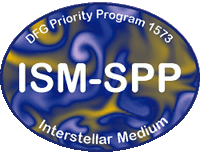DFG Priority Program 1573
Announcement
The Physics of the ISM
6 years of ISM-SPP 1573: what have we learned?
The final conference of the ISM-SPP will be held in Cologne, Germany February 13 - 17, 2017:Many physical processes in the ISM have been studied in isolation and under idealized conditions. It is however their nonlinear coupling that fully characterizes the structure and evolution of the multi-phase, dynamically evolving ISM. Therefore, the ISM-SPP was dedicated to study the interplay between various processes in the ISM during the last six years.
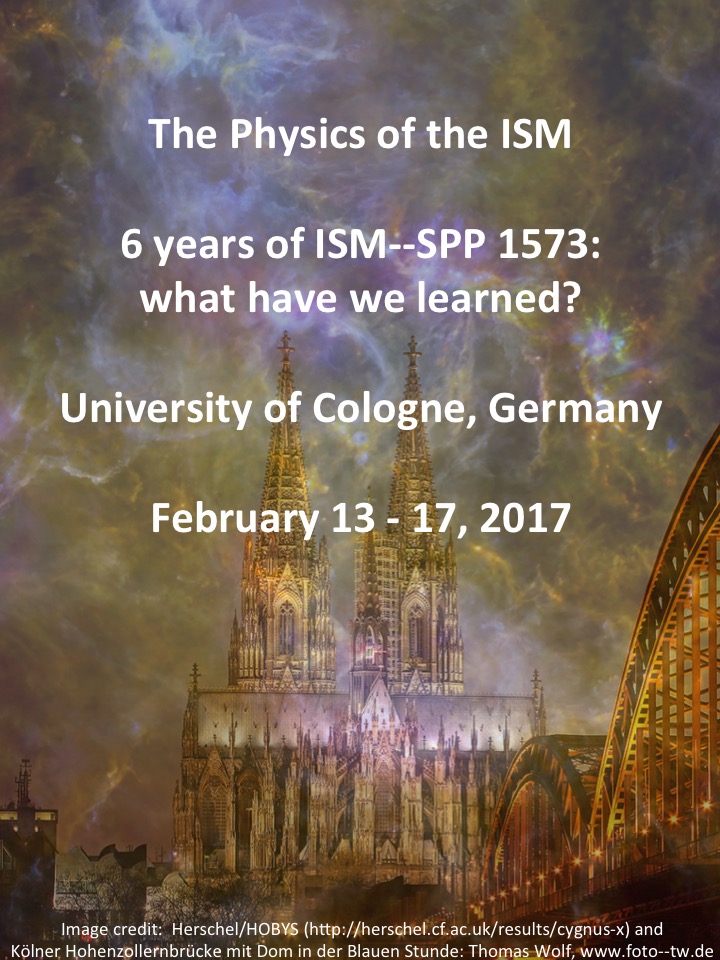 In this conference,
we aim at (i) summarizing the recent progress as well as (ii)
bringing together experts from all three research pillars -
laboratory studies, observations as well as theory and computations
- in order to form a consistent picture of relevant physical
processes in the ISM. We plan to tackle the recent progress in these
nine sessions:
In this conference,
we aim at (i) summarizing the recent progress as well as (ii)
bringing together experts from all three research pillars -
laboratory studies, observations as well as theory and computations
- in order to form a consistent picture of relevant physical
processes in the ISM. We plan to tackle the recent progress in these
nine sessions:
- 1. Observations of multi-scale structure in the ISM
- 2. Turbulence and dynamics of the ISM and their influence
on structure formation - 3. Structure formation and scaling relations in the ISM
- 4. The magnetized ISM and its influence on structure
formation - 5. Feedback and phase transitions in the ISM
- 6. The chemistry of the ISM
- 7. The physics of dust
- 8. The ISM in extreme environments
- 9. Connecting the ISM and its galactic environment
- provide classes and tutorials on how to install and run GANDALF (including dependencies)
- show the internal structure of the code and demonstrate how to best add new physics modules
- discuss the main hydrodynamical, radiative transport and other physics modules and explain the physical scenarios in which to use each available o\ ption
- demonstrate the capabilities of the Python analysis tools and how to set-up initial conditions, run simulations and prepare plots from Python scri\ pts
- discuss general issues relating to numerical methods in Astrophysics, in particular with Hydrodynamics.
- Dynamical structure and formation history- How are luminous and dark matter distributed in galaxies? Does the (internal) structure of galaxies reflect fossil records of their formation?
- Interstellar Medium- Where does the gas in galaxies come from? What controls the gas heating and cooling?
- Star formation- Why do stars form where they form in a galaxy? On which time-scales are stars being formed?
- Energetic phenomena- Are energetic phenomena (AGN, starburst) the cause for quenching? What is the physical impact on a galaxy's fate of these phenomena?
- 1. Observational results on far-IR fine-structure lines in the Milky Way, in nearby galaxies, and at high-z.
- 2. Theory and models of fine-structure line emission.
- 3. Power and limits of fine-structure lines as probes of the ISM physics.
- 4. The future of fine-structure line studies in the light of the next generation of instruments.
- homepage of the ISM Splinter
- homepage of the AG meeting
- full schedule of the AG meeting
- general registration site of the AG meeting
| Scientific organizing committee | Local organizing committee | ||
| João Alves | Paola Caselli | Andreas Burkert | Matthias Gritschneder |
| Richard Crutcher | Clare Dobbs | Daniel Seifried | Stefanie Walch |
| Bruce Elmegreen | Fabian Heitsch | Nassim Tanha | TAC PhD students |
| Mark Krumholz | Steve Longmore | ||
| Jürgen Stutzki | |||
For further information and registration, please visit: https://hera.ph1.uni-koeln.de/~ism2017/
Upcoming Conferences
Past Conferences
3 Oct - 7 Oct 2016: The ISM-SPP Olympian School of Astrophysics 2016 - Paralia Katerini, Mount Olympus, Greece
15 Sept - 16 Sept 2016: Turbulence and Magnetic Fields in the ISM (TMF) Splinter Meeting at the AG-Tagung, Bochum
13 Sept - 16 Sept 2016: Multiple Faces of Interstellar Dust - Garching
26 June - 1 July 2016: EPOS 2016 - Ringberg Castle, Tegernsee
4 April - 5 April 2016: Filaments 2016 - Kardinal-Doepfner Haus, Freising
ISM-SPP Student Workshop 2016
Kardinal-Doepfner Haus, Freising, March, 15-18, 2016
 We are happy to announce the ISM-SPP Student Workshop. The workshop will
take place from March 15 to March 18 2016, in Kardinal-Doepfner Haus,
Freising (Germany). The aim of the workshop is to give some theoretical
and computational aspects in the topics of ISM feedback and galaxy
dynamics. Furthermore the goal is to bring the students of ISM-SPP
together and to exchange the knowledge, to broad presentation skills and
to meet each other.
We are happy to announce the ISM-SPP Student Workshop. The workshop will
take place from March 15 to March 18 2016, in Kardinal-Doepfner Haus,
Freising (Germany). The aim of the workshop is to give some theoretical
and computational aspects in the topics of ISM feedback and galaxy
dynamics. Furthermore the goal is to bring the students of ISM-SPP
together and to exchange the knowledge, to broad presentation skills and
to meet each other.
For further information and registration, please visit:
ISM-SPP School: Computational Astrophysics with GANDALF
Kardinal-Doepfner Haus, Freising, October 26-30, 2015
The school will take the form of a series of lectures coupled with practical sessions, presented by the code's authors Dr David Hubber and Dr Giovanni Rosotti, where participants will work through a series of exercises to gain practical experience at using all aspects of the GANDALF code. The meeting will also have some slots available for contributed talks. In the spirit of the school, we would like to have the talks relating to either projects with GANDALF, numerical methods in Astrophysics or closely related topics. If you have a science result that you are interested in presenting, please consider bringing a poster instead. There is ample space for poster contributions and all participants are guaranteed to have the opportunity to present one if they wish to. The main aims of this school are to:For further information and registration, please visit:
Laboratory Astrophysics Workshop Heidelberg 2015
Max-Planck Institute for Nuclear Physics Heidelberg, October 1-2 2015
The annual laboratory astrophysics workshop brings together German groups working on topics of laboratory astrophysics and astrochemistry and guests fr\ om Europe and abroad. The workshops are intended to provide updates on recent developments in the field and foster collaboration and the exchange of id\ eas among the groups.For further information and registration, please visit:
A 3D View on Galaxy Evolution: from Statistics to Physics
Haus der Astronomie Heidelberg, July 6-10, 2015
To decipher the underlying processes that shape galaxies over time, we need to uncover their physical properties and the conditions controlling them. This in turn requires in-depth measurements of the stars, gas and dust, inside as well as surrounding the galaxies. The advent of new powerful spectral imagers in the optical and radio to (sub-)millimeter domain is providing now the opportunity to obtain detailed 3D information about the physical properties of these components in nearby galaxies. In the optical, several larger integral-field unit surveys like CALIFA, SAMI, and MaNGA are underway to gather detailed information on the distribution, kinematics and chemical properties of the stars and ionized gas in galaxies of different morphological types and in different environments. The (sub-)millimeter interferometers ALMA and NOEMA can provide similar detailed information for the molecular gas (and dust), though for a smaller number of galaxies. The coming years thus provide a unique opportunity to link research with spectral imagers across wavelengths and gain unprecedented insights in the physics determining a galaxy's fate.We propose a workshop to search for synergy approaches between the optical and radio community to progress our physical understanding of the evolution of galaxies across the Hubble sequence. With these constraints from nearby galaxies providing a benchmark for high(er) redshift galaxy observations as well as for galaxy formation models in a cosmological context, we are also aiming for targeted contributions by scientists from both these communities. The format will be that of a classical workshop with a review talk followed by invited and contributed talks as well as ample time for discussions. One particular aim of the workshop is to identify potential areas where dedicated efforts from both the optical and radio community can lead to major scientific break-throughs.
Questions to be addressed include:
For further information and registration, please visit:
FIR Fine Structure Lines Workshop
Haus der Astronomie Heidelberg, June 8-11, 2015
The far-IR fine-structure lines (e.g.[CII] 158μm, [OIII] 88μm, [NII] 122μm, etc.) are powerful probes of the physical conditions of the various ionized, atomic, and molecular phases of the interstellar medium (ISM) in which they arise. They are usually optically thin and weakly affected by extinction due to dust. As such, these lines serve as important coolants of their respective phases of the ISM - in some cases they are the dominant coolants. Given their brightness, the FIR fine-structure lines are potentially a vital tool in studying the physics of gas and its connection with star formation both in our own and in other galaxies, even at the earliest epochs of the universe. Yet if we are to to fully realize this potential we must address the open questions posed by early work (e.g., what causes the "CII Deficit"?).The astrophysical power of the FIR fine-structure lines and desire to address open questions surrounding them motivate this workshop. Exciting results from Herschel studies of the FIR fine-structures lines in nearby systems (e.g. KINGFISH, GOALS, GOT C+) are now regularly appearing in press, while high-z detections of the lines with ALMA, PdBI, Herschel, ZEUS, etc. are now nearly commonplace. Furthermore, SOFIA is making important observations of the lines in the Milky Way via the GREAT and FIFI-LS instruments.
The goal of this workshop is to bring together modelists and observers who use far-IR fine-structure lines to understand the physics of the ISM both at small and large scales, from Galactic environment to local galaxies and to the highest redshifts. In particular, we will discuss:
For further information and registration, please visit:
ISM-SPP Period II Kick-off School/Workshop
Kardinal-Doepfner Haus, Freising, April 27-30, 2015
We are happy to announce the kickoff school and workshop for the ISM-SPP funding period II. The school will take place from April 27 to April 28, 2015, the workshop will take place from April 29 to April 30. The aim of this meeting will be to provide a platform for interdisciplinary interaction between the researchers working on the physics of the Interstellar medium, to discuss the future of ISM research as well as future funding possibilities for the ISM community Participants will have the opportunity to present their work, exchange ideas and discuss with established researchers the big questions and challenges in the field of ISM physics as well as future research opportunities. The idea of the school is: (i) giving a summary of our current view of the ISM based on observations, laboratory experiments and simulations (ii) to bring together the students of the ISM-SPP community for discussion, exchange of ideas and expertise, networking (iii) give students the opportunity to improve their presentation skills The idea of the workshop is to introduce the newly funded and the refunded projects to one another.In addition, we plan to look into funding possibilities beyond the period II of the ISM-SPP.For further information and registration, please visit:
Structure of Filaments in molecular clouds and their relation to the star-formation processes
USM, Munich, March 23-25, 2015
Filamentary structures are commonplace in giant molecular clouds and seem to be fundamental during the earliest stages of star formation. Large scale filaments have been known for many years from extinction maps of low-mass star-forming regions or were identified in the (sub-)millimetre wavelength range in high-mass star forming regions. More recently, observations carried out using the Herschel space telescope in nearby star-forming regions, as well as in regions where star formation is not currently active, have revealed a wealth of filaments. Filaments are thought to be the consequence of thermal and dynamical instabilities caused by collisions of large-scale warm flows. These flows are themselves generated by the turbulent velocity fields that are also ubiquitous in GMCs. Filaments can also be produced by gravitational instabilities acting on dense two-dimensional structures. Such processes result from the expansion of a feedback-driven bubble or from the collision of two GMCs. Numerical simulations of star formation on GMC scales became in recent years sophisticated enough to allow detailed quantitative comparisons with observations. Indeed, such comparisons are a prerequisite for a continuing progress in this field. The aim of the workshop is to bring together and stimulate the discussion between the communities of theoreticians and observers. We will discuss and evaluate recent theoretical and observational developments in the study of filaments with a focus on developing a common framework to properly interpret the new observations that will become available in the next few years. We will also initiate a discussion on a possible application for a third-party funding (e.g. through a Marie Curie action) to begin a multidisciplinary international collaboration on the role of filaments in the star formation process.For further information and registration, please visit:
Superbubbles, HI holes and Supershells
Kardinal-Döpfner-Haus Freising, November 10-12, 2014
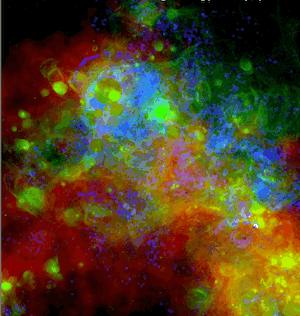 The energy output of massive stars plays an important role in the evolution of star-forming galaxies. The observational signatures of superbubbles are commonly 100 pc to kpc sized structures in the interstellar medium: the interior sometimes emits X-rays, the absence of colder gas in the same place has motivated the term HI holes, whereas 'supershells' refers to HI and emission line features in the cavity walls. Superbubbles are important structuring elements in star-forming galaxies and are the main source of hot gas. They sweep up denser gas, which may trigger further star formation. When they open up into the gaseous halo of galaxies, they mediate the exchange of mass, metals, Cosmic rays and magnetic fields with the halo and beyond. When superbubbles combine they may trigger substantial galactic outflows. Despite the importance of superbubbles in the context of galactic-scale feedback, basic questions are still unanswered: where does the injected energy go? Which conditions lead to galactic winds, which ones to galactic fountains? How is the dynamics in different gas phases linked to the energy input and the star formation? What is the role of Cosmic rays and magnetic fields? How can we predict mass and energy outflow rates? In order to answer such questions, it is necessary to combine multi-wavelength data with theoretical work. The aim of this workshop is to bring together experts in the respective areas to review recent progress and promote synergies across the field. This is now particularly timely, because hot gas velocities in the Milky Way have just recently been measured via radioactive decay lines with the INTEGRAL satellite, because of other new data from e.g. the ALMA, Effelsberg, eVLA, FERMI and Herschel telescopes, and also because of advances in the theoretical realm, not only due to the steady increase of computer power, but also via progress regarding code development, e.g. the inclusion on non-equilibrium ionisation into hydrodynamic simulations. Last but not least, it is now time to prepare for eROSITA, which is expected to produce a new soft X-ray all-sky survey where superbubbles in nearby galaxies will feature prominently.
The energy output of massive stars plays an important role in the evolution of star-forming galaxies. The observational signatures of superbubbles are commonly 100 pc to kpc sized structures in the interstellar medium: the interior sometimes emits X-rays, the absence of colder gas in the same place has motivated the term HI holes, whereas 'supershells' refers to HI and emission line features in the cavity walls. Superbubbles are important structuring elements in star-forming galaxies and are the main source of hot gas. They sweep up denser gas, which may trigger further star formation. When they open up into the gaseous halo of galaxies, they mediate the exchange of mass, metals, Cosmic rays and magnetic fields with the halo and beyond. When superbubbles combine they may trigger substantial galactic outflows. Despite the importance of superbubbles in the context of galactic-scale feedback, basic questions are still unanswered: where does the injected energy go? Which conditions lead to galactic winds, which ones to galactic fountains? How is the dynamics in different gas phases linked to the energy input and the star formation? What is the role of Cosmic rays and magnetic fields? How can we predict mass and energy outflow rates? In order to answer such questions, it is necessary to combine multi-wavelength data with theoretical work. The aim of this workshop is to bring together experts in the respective areas to review recent progress and promote synergies across the field. This is now particularly timely, because hot gas velocities in the Milky Way have just recently been measured via radioactive decay lines with the INTEGRAL satellite, because of other new data from e.g. the ALMA, Effelsberg, eVLA, FERMI and Herschel telescopes, and also because of advances in the theoretical realm, not only due to the steady increase of computer power, but also via progress regarding code development, e.g. the inclusion on non-equilibrium ionisation into hydrodynamic simulations. Last but not least, it is now time to prepare for eROSITA, which is expected to produce a new soft X-ray all-sky survey where superbubbles in nearby galaxies will feature prominently.
For further information and registration, please visit:
ISM-SPP School 2014 - Laboratory Astrophysics
Tabarz, October 13-17, 2014
The summer school "Laboratory Astrophysics" is organized within the framework of the DFG Priority Program "Physics of the Interstellar Medium" (ISM-SPP 1573). Its goal is to present the role played by laboratory studies in the identification of the chemical and physical processes that take place in the interstellar medium (ISM). For this purpose, introductory lectures on the interstellar matter will present scientific problems and issues to which laboratory studies can bring solutions. Each introduction will be followed by topical lectures on the current research themes in the field of laboratory astrophysics and the techniques that are implemented. Internationally-known scientists will give the lectures. The program will end with a seminar on soft skills, that is science communication. The school is intended for PhD students and postdoctoral researchers from the field of astrophysics or fields related to astrophysics who wish to familiarize themselves with works currently carried out in laboratories and the needs of astronomers for laboratory data.For further information and registration, please visit:
The Interstellar Medium
Annual Meeting of the AG 2014, Splinter Session J, September 25-26, 2014
 A characteristic property of the interstellar medium is its astonishing dynamics: turbulent high average density regions ('clouds') form, for example by converging flows, and disperse again due to energy release from stars. Even on the largest scales, significant inflows and outflows of often multi-phase gas is observed, and essential to explain the amount of gas in galaxies, or enriched gas outside galaxies. Since it is partly ionised, magnetic fields are amplified by the dynamics. The dynamics is also vital for the mixing of freshly ejected metals into all the phases of the interstellar medium. The entire electromagnetic spectrum contributes and time-dependent simulations are required to interpret the data. This splinter meeting will focus on recent developments in the area of interstellar medium research.
A characteristic property of the interstellar medium is its astonishing dynamics: turbulent high average density regions ('clouds') form, for example by converging flows, and disperse again due to energy release from stars. Even on the largest scales, significant inflows and outflows of often multi-phase gas is observed, and essential to explain the amount of gas in galaxies, or enriched gas outside galaxies. Since it is partly ionised, magnetic fields are amplified by the dynamics. The dynamics is also vital for the mixing of freshly ejected metals into all the phases of the interstellar medium. The entire electromagnetic spectrum contributes and time-dependent simulations are required to interpret the data. This splinter meeting will focus on recent developments in the area of interstellar medium research.
For further information and registration, please visit:
KROME computational school 2014
Universität Göttingen, September 17-19, 2014
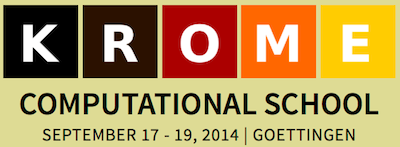 The aim of this first bootcamp is to introduce the features of the package through a detailed description of the main physical processes included in KROME.
The main goals are:
(i) to introduce the users to the fundamental state-of-art chemical-physical modelling of astronomical environment and to directly relate each process with the KROME options. In this way the users will be able to built their own astrophysical models with ease.
(ii) to help the users to embed KROME in their own codes and understand in which way they can speed-up the solution of the rate-equations playing with the solver options and various optimizations technique.
(iii) to introduce the users to the bitbucket platform and discuss the main steps needed to be part of the KROME community. Advanced customization will be introduced to allow the users to modify the package contributing to the future development.
The aim of this first bootcamp is to introduce the features of the package through a detailed description of the main physical processes included in KROME.
The main goals are:
(i) to introduce the users to the fundamental state-of-art chemical-physical modelling of astronomical environment and to directly relate each process with the KROME options. In this way the users will be able to built their own astrophysical models with ease.
(ii) to help the users to embed KROME in their own codes and understand in which way they can speed-up the solution of the rate-equations playing with the solver options and various optimizations technique.
(iii) to introduce the users to the bitbucket platform and discuss the main steps needed to be part of the KROME community. Advanced customization will be introduced to allow the users to modify the package contributing to the future development.
For further information and registration, please visit:
StarBench-II: Benchmarking Star Forming codes
AIfa/MPIfR, Bonn, September 1-5, 2014
 Radiation-hydrodynamical simulations are a powerful tool for
understanding the dynamical evolution of the interstellar medium (ISM)
leading to star and planet formation. Star formation, feedback, and ISM
evolution are important fields of research, in which recent advances
have depended heavily on computational astrophysics studies using
large-scale HPC resources, and huge investment of human effort. Planet
formation and evolution has emerged as a new research frontier closely
linked to star formation. There is also obvious synergy between studying
the Heliosphere and the stellar winds of distant stars. Innovative
algorithms are constantly being developed by many groups worldwide,
offering new and powerful tools for examining star formation and feedback.
There is a pressing need for benchmark tests to validate the accuracy of
these algorithms and results. In particular, we seek to define
well-posed problems that can be tested against known analytic solutions,
which all codes modelling a particular process should be able to solve
accurately. This meeting will be dedicated to the technical comparison
of codes and to round-table discussions for the pros and cons of each
method. In this frame of work, participants will be asked to run the
test cases with their codes before the meeting, the results of which
will be used for the discussion during the meeting.
Radiation-hydrodynamical simulations are a powerful tool for
understanding the dynamical evolution of the interstellar medium (ISM)
leading to star and planet formation. Star formation, feedback, and ISM
evolution are important fields of research, in which recent advances
have depended heavily on computational astrophysics studies using
large-scale HPC resources, and huge investment of human effort. Planet
formation and evolution has emerged as a new research frontier closely
linked to star formation. There is also obvious synergy between studying
the Heliosphere and the stellar winds of distant stars. Innovative
algorithms are constantly being developed by many groups worldwide,
offering new and powerful tools for examining star formation and feedback.
There is a pressing need for benchmark tests to validate the accuracy of
these algorithms and results. In particular, we seek to define
well-posed problems that can be tested against known analytic solutions,
which all codes modelling a particular process should be able to solve
accurately. This meeting will be dedicated to the technical comparison
of codes and to round-table discussions for the pros and cons of each
method. In this frame of work, participants will be asked to run the
test cases with their codes before the meeting, the results of which
will be used for the discussion during the meeting.
For further information and registration, please visit:
Chemical Diagnostics in the ALMA/NOEMA Era
Heidelberg, July 21-23, 2014
 The Max Planck Institute for Astronomy (MPIA) together with a Priority Programme 1573 of the German Science Foundation are happy to announce a small (~35 participants) focused workshop on "Chemical Diagnostics in the ALMA/NOEMA Era". This 3-day intense workshop will take place July 21st - July 23rd, 2014, at the Haus der Astronomie in Heidelberg, Germany.
The workshop aims to bring together observers and theorists from the Galactic and extra-galactic communities who work on understanding how (sub-)millimeter multi-line observations can be used to further our understanding of the Interstellar Medium (ISM) and its relation to energetic processes such as, e.g., star formation and Active Galactic Nuclei, in particular in the era of ALMA and NOEMA. We plan to have a mix of theoretical and observational talks, and link the Galactic and extragalactic communities, and as well as plenty of free time for scientific discussions.
The Max Planck Institute for Astronomy (MPIA) together with a Priority Programme 1573 of the German Science Foundation are happy to announce a small (~35 participants) focused workshop on "Chemical Diagnostics in the ALMA/NOEMA Era". This 3-day intense workshop will take place July 21st - July 23rd, 2014, at the Haus der Astronomie in Heidelberg, Germany.
The workshop aims to bring together observers and theorists from the Galactic and extra-galactic communities who work on understanding how (sub-)millimeter multi-line observations can be used to further our understanding of the Interstellar Medium (ISM) and its relation to energetic processes such as, e.g., star formation and Active Galactic Nuclei, in particular in the era of ALMA and NOEMA. We plan to have a mix of theoretical and observational talks, and link the Galactic and extragalactic communities, and as well as plenty of free time for scientific discussions.
For further information, please visit:
Review Panel Meeting for the Second Funding Period
Freising, June 16-17, 2014
 The Review Panel Meeting for the second ISM-SPP funding period will
take place from June 16 to 17, 2014 in the
Kardinal-Doepfner-Haus in Freising near Munich.
All principal investigators ("Antragsteller") or their representatives
are invited to participate and present their proposal to the review panel during
three poster sessions.
In addition to the poster presentations, there will be a summary talk
of the first funding period by the coordinator Prof. Andreas Burkert
and ample time for scientific discussion.
The Review Panel Meeting for the second ISM-SPP funding period will
take place from June 16 to 17, 2014 in the
Kardinal-Doepfner-Haus in Freising near Munich.
All principal investigators ("Antragsteller") or their representatives
are invited to participate and present their proposal to the review panel during
three poster sessions.
In addition to the poster presentations, there will be a summary talk
of the first funding period by the coordinator Prof. Andreas Burkert
and ample time for scientific discussion.
For further information, please visit:
The Early Phases of Star Formation 2014
Ringberg Castle, Tegernsee, June 1-6, 2014
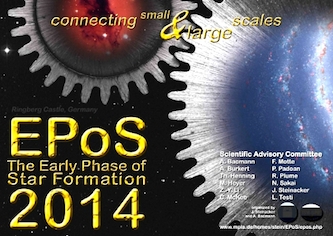 Many orders of magnitude in scale lie between the motions within a
galaxy creating giant molecular clouds and the local site where stars
are forming
from a cloud core. Yet, with simulations and observations increasing
their bandwith in scale resolution we start probing the
relation between the large-scale initial conditions of star formation
and the properties of the young stellar objects in
their earliest phase.
EPoS 2014 aims to update our views on the onset of star formation with
a focus on connecting large and small scale
processes.
Both early formation of stars from the low- to the high-mass regime
are considered. Individual astrophysical topics of interest are:
triggered star formation, clustered star formation, cores, chemistry,
collapse, fragmentation, jets, competitive accretion, giant molecular
clouds, binarity, magnetic fields, initial mass function, turbulence,
X-rays, and early phases of disks.
Many orders of magnitude in scale lie between the motions within a
galaxy creating giant molecular clouds and the local site where stars
are forming
from a cloud core. Yet, with simulations and observations increasing
their bandwith in scale resolution we start probing the
relation between the large-scale initial conditions of star formation
and the properties of the young stellar objects in
their earliest phase.
EPoS 2014 aims to update our views on the onset of star formation with
a focus on connecting large and small scale
processes.
Both early formation of stars from the low- to the high-mass regime
are considered. Individual astrophysical topics of interest are:
triggered star formation, clustered star formation, cores, chemistry,
collapse, fragmentation, jets, competitive accretion, giant molecular
clouds, binarity, magnetic fields, initial mass function, turbulence,
X-rays, and early phases of disks.
For further information, please visit:
The Olympian Symposium on Star Formation
Mount Olympus (Greece), May 26-30, 2014

During the past decade, significant efforts have been made to investigate the physics and chemistry of the interstellar medium and the associated star formation. Theoretical studies, advanced numerical models and observations have led to great insights into the life cycle of the interstellar medium. However, they also generated a plethora of interesting but thus far unanswered questions. The aim of the conference is to bring together both the theoretical and observational scientific communities to address the most recent advances in our knowledge of the evolution of the interstellar medium and the associated star formation. Our discussion will include the physics and chemistry of ionized nebulae; the role of feedback, turbulence and magnetic fields; the structure of photodissociation regions; the role of heating and cooling processes in regulating star formation; the interplay between MHD turbulence,self-gravity, time-dependent chemistry, and the external (and internal) radiation field; the comparison of observed and simulated data cubes.
For further information and registration, please visit:
ISM-SPP Student Meeting
Freising, May 7th - 9th, 2014
 The aim of this meeting will be to provide a platform for interdisciplinary
interaction between young researchers working on the physics of the
Interstellar medium, to discuss the future of ISM research as well as
career opportunities for young scientists.
Participants will have the opportunity to present their work, exchange
ideas and discuss with established researchers the big questions and
challenges in the field of ISM physics as well as future research
opportunities.
The meeting will have three main parts:
i) Future Career: Applying for funding and career opportunities for young
researchers
ii) Future Science: Discussion with experts on the big questions and
exciting new challenges in ISM physics.
iii) Short presentations by students and informal get-together.
The aim of this meeting will be to provide a platform for interdisciplinary
interaction between young researchers working on the physics of the
Interstellar medium, to discuss the future of ISM research as well as
career opportunities for young scientists.
Participants will have the opportunity to present their work, exchange
ideas and discuss with established researchers the big questions and
challenges in the field of ISM physics as well as future research
opportunities.
The meeting will have three main parts:
i) Future Career: Applying for funding and career opportunities for young
researchers
ii) Future Science: Discussion with experts on the big questions and
exciting new challenges in ISM physics.
iii) Short presentations by students and informal get-together.
Confirmed speakers include: Henrik Beuther, Andreas Burkert, Thomas Preibisch, David Hubber, Marc Schartmann, Leonardo Testi
For further information and registration, please visit:
SOFIA winter school 2014
Universität zu Köln, February 10-14, 2014
 The first SOFIA winter school is intended to bring together young
astronomers, scientists, and experienced SOFIA users from the German
community at a 5 day meeting dealing with SOFIA relevant astrophysics of the interstellar medium.
The winter school is organized by the DFG Schwerpunkt-Programm Physics
of the Interstellar Medium and the
DFG Sonderforschungsbereich SFB 956 Conditions and Impact of Star Formation.
The workshop will include lectures on the physics of the interstellar
medium (ISM), such as basics of spectroscopy,
dust polarimetry, and the dynamics of the ISM, but also practical
courses targeting proposal preparation soft skills
and preparation/simulation of observations. Special focus will be on the German PI instruments GREAT and FIFI-LS.
On Thursday 13 Feb. 2014, we will have a
discussion on SOFIA future instrumentation, both in
the sense of scientific topics and technological possibilities.
The first SOFIA winter school is intended to bring together young
astronomers, scientists, and experienced SOFIA users from the German
community at a 5 day meeting dealing with SOFIA relevant astrophysics of the interstellar medium.
The winter school is organized by the DFG Schwerpunkt-Programm Physics
of the Interstellar Medium and the
DFG Sonderforschungsbereich SFB 956 Conditions and Impact of Star Formation.
The workshop will include lectures on the physics of the interstellar
medium (ISM), such as basics of spectroscopy,
dust polarimetry, and the dynamics of the ISM, but also practical
courses targeting proposal preparation soft skills
and preparation/simulation of observations. Special focus will be on the German PI instruments GREAT and FIFI-LS.
On Thursday 13 Feb. 2014, we will have a
discussion on SOFIA future instrumentation, both in
the sense of scientific topics and technological possibilities.
For further information and registration, please visit:
Physical processes in the ISM
MPE Garching, October 21-25, 2013

Many physical processes in the ISM have been studied in isolation and under idealized conditions. It is however their nonlinear coupling that fully characterizes the structure and evolution of the multi-phase, dynamically evolving ISM. Therefore, the first funding period of the ISM-SPP (ism-spp.de) is dedicated to the investigation of the interplay between various processes in the ISM. In this conference, we aim at (i) summarizing the recent progress and isolating the open questions as well as (ii) bringing together experts from all three research pillars (laboratory studies, observations as well as theory and computations) in order to form a consistent picture of relevant physical processes in the ISM.
For further information and registration, please visit:
Astrophysical Turbulence: From Galaxies to Planets
Max-Planck-Institut für Physik komplexer Systeme, Dresden, Oct 7 - 11, 2013
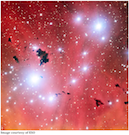
In astrophysics and cosmology, fluid flow occurs on a large range of scales and under very different conditions, from the dense interior of stars and planets to the highly rarefied intergalactic medium. These flows share the fact that they are generally turbulent, i.e. highly disordered both in space and time. Turbulence is one of the key processes for the structure and evolution of a large variety of geo- and astrophysical systems. The universality of astrophysical turbulence interlinks the physics of the interior of planets or stars with proto-planetary or galactic disks, as well as the intergalactic gas outside of galaxies. For example, angular momentum transport by turbulence is a central question that must beanswered to understand how galaxies or stars form, how proto-planetary disks evolve, how metals are mixed in the interstellar and intergalactic medium, or how differential rotation is established in stars and planets. Magnetic field amplification through turbulent dynamo processes is ubiquitous in planets, stars, and galaxies. The onset of instabilities due to dust particles or newly formed planets in proto-planetary disks controls the properties of the evolving structures. We can observe a variety of interactions between stars, planets and galaxies with their environment leading to the exchange of energy and (angular-) momentum. This compilation highlights the enormous potential and perspective of a combined workshop/school to discuss and deepen our knowledge in this very rapidly moving field of research.
For further information and registration, please visit:
Laboratory Astrophysics 2013
Kassel, Sept 30 - Oct 2, 2013
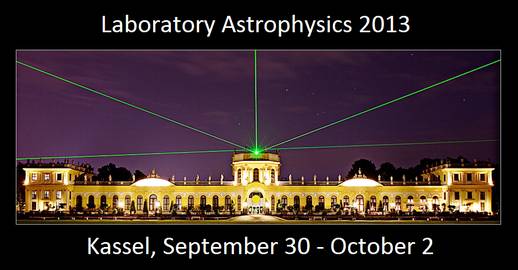
The conference focusses on recent developments in the field of laboratory astrophysics, bringing together laboratory groups of the DFG Priority Program 1573, Physics of the Interstellar Medium. Key aspects of this year's meeting are interstellar grains and related molecular species as well as molecular ions in cold environments.
For further information and registration, please visit:
Energising the ISM
Annual Meeting of the AG 2013, Splinter Session I, September 24, 2013
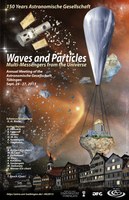 The interstellar medium (ISM) is highly turbulent. Left on its own, turbulence decays on a short timescale and the energy is finally lost to
radiation. Hence, the ISM is constantly energised. The energy sources include massive stars, large-scale rotational energy and energy released
during accretion on to compact objects.
The effect of the energy input can be observed in different gas phases, Cosmic ray emission and the magnetic field and leads to the observed
structuring of the ISM, for example bubbles, superbubbles, galactic fountains and winds. Different perspectives are offered from studies in the
Milky Way and in external galaxies, where the structure of a given system impacts on the ISM dynamics.
This session is intended to bring together observers and theorists in the field. The idea is to give the opportunity to present recent results
and also to have some time for discussion. People with posters are encouraged to advertise them on one slide.
The interstellar medium (ISM) is highly turbulent. Left on its own, turbulence decays on a short timescale and the energy is finally lost to
radiation. Hence, the ISM is constantly energised. The energy sources include massive stars, large-scale rotational energy and energy released
during accretion on to compact objects.
The effect of the energy input can be observed in different gas phases, Cosmic ray emission and the magnetic field and leads to the observed
structuring of the ISM, for example bubbles, superbubbles, galactic fountains and winds. Different perspectives are offered from studies in the
Milky Way and in external galaxies, where the structure of a given system impacts on the ISM dynamics.
This session is intended to bring together observers and theorists in the field. The idea is to give the opportunity to present recent results
and also to have some time for discussion. People with posters are encouraged to advertise them on one slide.
For further information and registration, please visit:
Phases of the ISM
2013 MPIA Summer Conference

The conference will take place July 29-Aug 1, 2013 at the Haus der Astronomie in Heidelberg, Germany. The scientific program will cover what we know about ISM phases in the Milky Way and other galaxies, and how we expect these phases to vary within our own Galaxy and across different galaxy types. We will discuss how we can disentangle and use observational tracers like the 158 micron line of C+ that arise from the various ISM phases. The conference will have a mix of theoretical and observational talks, with topics extending from the Galactic ISM to the high-redshift universe. We have an exciting line-up of invited speakers who will review the state of the field.
For further information and registration, please visit:
Protostars and Planets VI
Heidelberg, July 15th - 20th, 2013
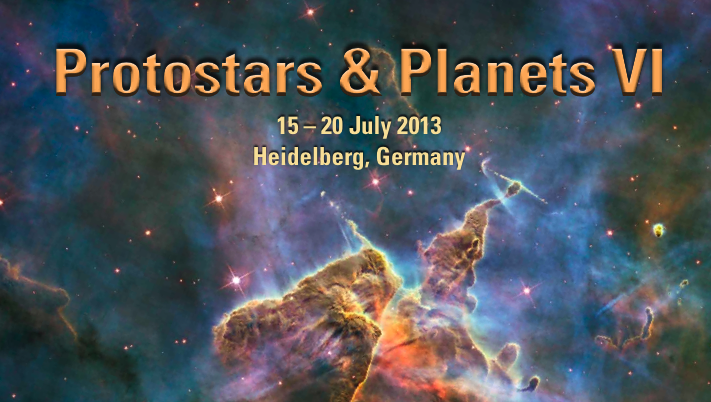 It is high time for a new Protostars and Planets conference and a corresponding book. The Protostars and Planets conference will take place in Heidelberg,
Germany, 15-20 July 2013. A call to the community for review chapters and their corresponding review talks can be found on the conference webpage.
The call allows free suggestions of topics, but the SAC and the editors found it useful to compile a stawman's topic/chapter list as a guideline
as to what they think the PPVI chapters might look like, which can be found on the webpage as well.
It is high time for a new Protostars and Planets conference and a corresponding book. The Protostars and Planets conference will take place in Heidelberg,
Germany, 15-20 July 2013. A call to the community for review chapters and their corresponding review talks can be found on the conference webpage.
The call allows free suggestions of topics, but the SAC and the editors found it useful to compile a stawman's topic/chapter list as a guideline
as to what they think the PPVI chapters might look like, which can be found on the webpage as well.
Regulation of star formation in molecular gas: from galactic to sub-cloud scales
Ringberg Castle, June 23-29, 2013

The workshop aims to bring together observers and theorists from the Galactic and extra-galactic communities who work on understanding how molecular gas is organized and how star formation relates to the molecular gas. The venue of Ringberg castle provides a unique atmosphere for small, focussed and interactive workshops (limited to 60 participants).
For further information and registration, please visit:
Magnetic Fields from Cloud Cores to Protostellar Disks
MPIA Heidelberg, May 21-24, 2013
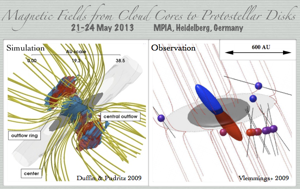 It is still under debate how exactly the ISM gas is transferred into protostellar disks from cloud cores.
Our goal is to get experts from different schools together to have dynamical discussion in order to reveal
the causes of the dramatic differences between numerical models.
Experienced observers are also invited for brainstorming the way to obtain constraints on competing scenarios.
For further information and registration, please visit:
It is still under debate how exactly the ISM gas is transferred into protostellar disks from cloud cores.
Our goal is to get experts from different schools together to have dynamical discussion in order to reveal
the causes of the dramatic differences between numerical models.
Experienced observers are also invited for brainstorming the way to obtain constraints on competing scenarios.
For further information and registration, please visit:
Gas Dynamics and Star Formation in the Extreme Environment of Galactic Nuclei
Ringberg Castle, March 18-22, 2013
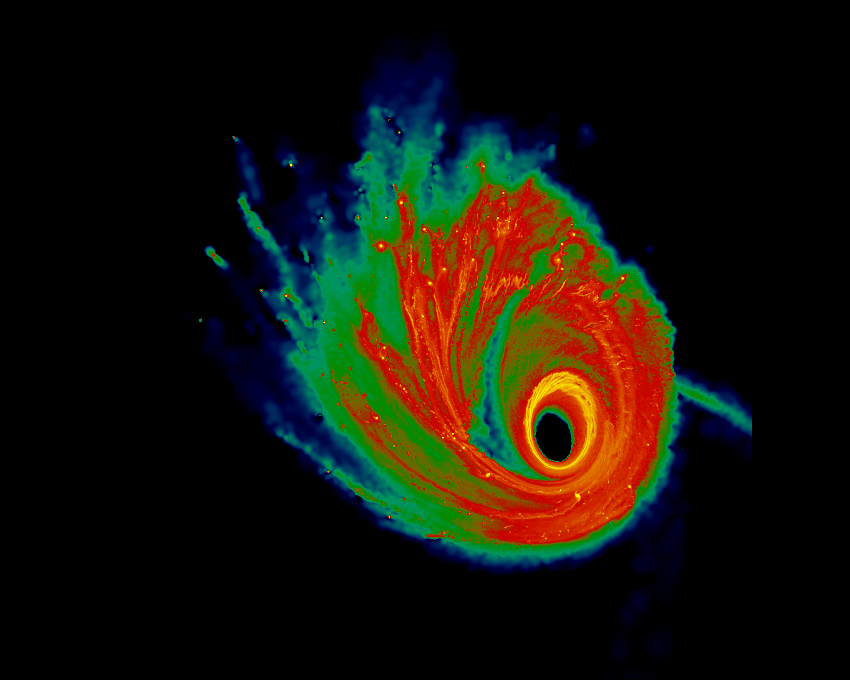 In recent years, observations have made huge progress in observing Galactic Nuclei of nearby galaxies in multiple wavelengths and high
resolution. In this Ringberg
Workshop, we are especially interested in what we can learn from our knowledge of the local ISM, what physical processes are the most
important to describe the dynamics and physics in general, how stars are able to form under these conditions as well as the relation
between nuclear star formation and feeding of the central supermassive black hole and (the onset of) nuclear activity cycles. Due to
its proximity, our own Galactic Centre (GC) is an ideal laboratory for studying the relevant processes under these extreme conditions.
One example is the recently detected fast moving gas cloud G2, which will pass the SMBH at a distance of only 2200 Schwarzschild radii
within the next couple of years.
The workshop is supposed to bring together selected international experts working on the physics of Galactic Nuclei to discuss
recent advances and is organized as a joint workshop of observers and theorists, located at MPE and MPA (Munich).
In recent years, observations have made huge progress in observing Galactic Nuclei of nearby galaxies in multiple wavelengths and high
resolution. In this Ringberg
Workshop, we are especially interested in what we can learn from our knowledge of the local ISM, what physical processes are the most
important to describe the dynamics and physics in general, how stars are able to form under these conditions as well as the relation
between nuclear star formation and feeding of the central supermassive black hole and (the onset of) nuclear activity cycles. Due to
its proximity, our own Galactic Centre (GC) is an ideal laboratory for studying the relevant processes under these extreme conditions.
One example is the recently detected fast moving gas cloud G2, which will pass the SMBH at a distance of only 2200 Schwarzschild radii
within the next couple of years.
The workshop is supposed to bring together selected international experts working on the physics of Galactic Nuclei to discuss
recent advances and is organized as a joint workshop of observers and theorists, located at MPE and MPA (Munich). For further information and registration, please visit:
Workshop on Laboratory Astrophysics
Bonn, November 21-23, 2012
 This workshop is intended to bring together people active in the field of laboratory astrophysics in Germany to exchange ideas and
foster collaborations. The laboratory groups in Jena, Kassel, Cologne and Heidelberg are organizers of this workshop as they are
part of the priority program "The physics of the interstellar medium" (SPP1573) of German Science Foundation (DFG). Funding of this
workshop is provided mainly through this priority program. The local organization is by the laboratory astrophysics group in Cologne.
Internationally renowned guests are invited to the meeting to bring new ideas to the groups. The scientific scope of the meeting
focusses this year on subjects relevant to the Bonn/Cologne group, namely molecules and their spectroscopy, isotopic species and
the influence of nuclear spin, as well as carbonaceous and silicon bearing molecules and grains.
For further information, including a list of invited speakers and a preliminary program and schedule, and for registration, please visit:
This workshop is intended to bring together people active in the field of laboratory astrophysics in Germany to exchange ideas and
foster collaborations. The laboratory groups in Jena, Kassel, Cologne and Heidelberg are organizers of this workshop as they are
part of the priority program "The physics of the interstellar medium" (SPP1573) of German Science Foundation (DFG). Funding of this
workshop is provided mainly through this priority program. The local organization is by the laboratory astrophysics group in Cologne.
Internationally renowned guests are invited to the meeting to bring new ideas to the groups. The scientific scope of the meeting
focusses this year on subjects relevant to the Bonn/Cologne group, namely molecules and their spectroscopy, isotopic species and
the influence of nuclear spin, as well as carbonaceous and silicon bearing molecules and grains.
For further information, including a list of invited speakers and a preliminary program and schedule, and for registration, please visit:
The low-metallicity ISM
Chemistry, Turbulence and Magnetic Fields, Göttingen, October 8-12, 2012

The ISM at low metallicity is a very prospective area of research, with potential applications in the field of high-redshift galaxies, the first generations of stars, as well as the local Universe, in particular with respect to nearby dwarf galaxies. In light of new theoretical results as well as new and upcoming observational data, the investigation of the ISM in this regime becomes increasingly more complex. Magnetic fields have been detected in local dwarf galaxies, and are expected on the grounds of dynamo theory. In this workshop, we aim to explore the low-metallicity ISM in the key areas chemistry, turbulence and magnetic fields. We plan to approach them both from a theoretical and an observational point of view, with particular emphasys on new missions like Herschel and ALMA.
Download the conference poster.
The Physics of the Interstellar Medium
- observations, laboratory experiments and simulations
I. ISM-SPP school, Freising, October 1st - 5th, 2012
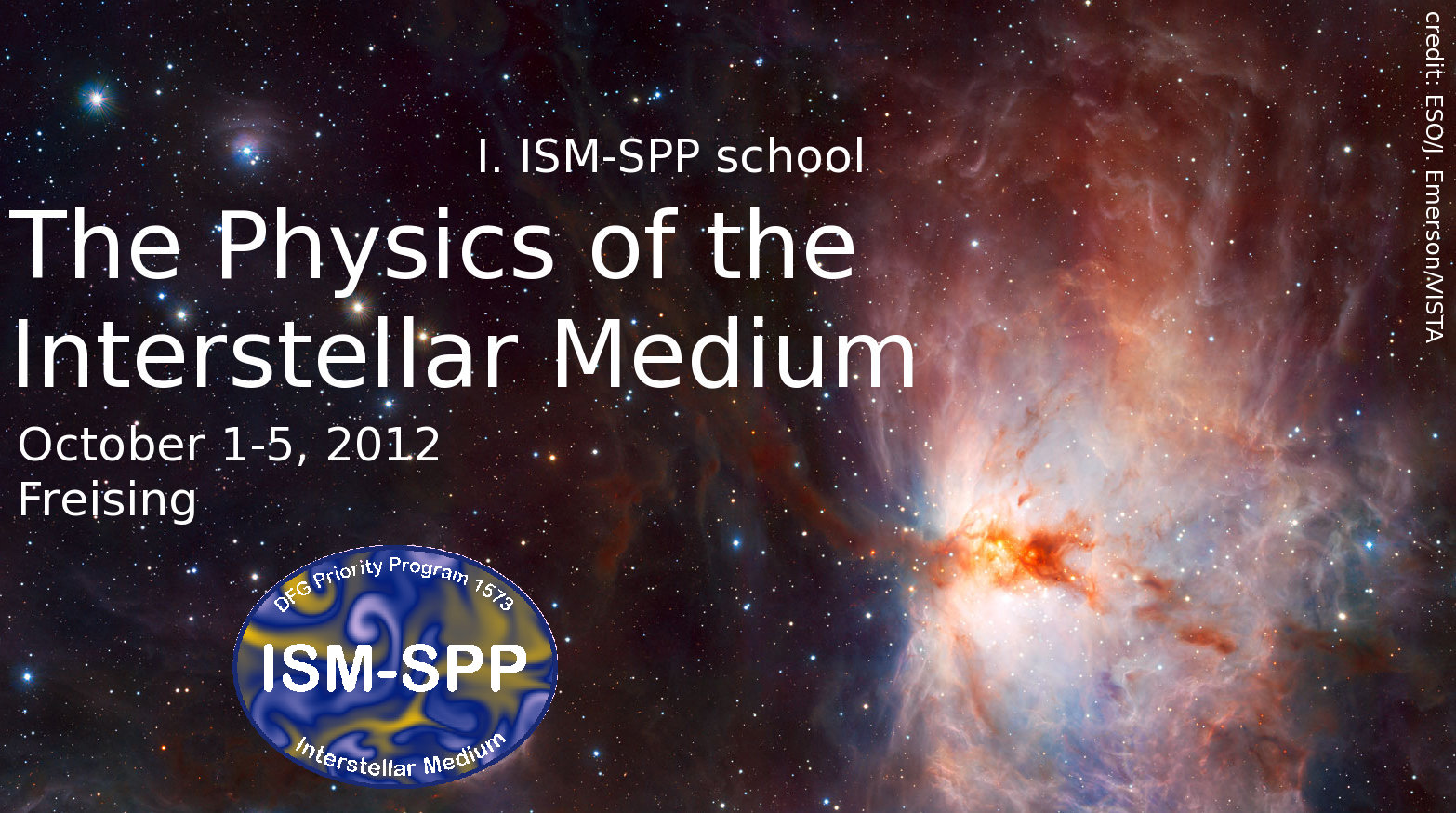
The idea of the first ISM-SPP school is: (i) giving a summary of our current view of the ISM based on observations, laboratory experiments and simulations (ii) to bring together the students of the ISM-SPP community for discussion, exchange of ideas and expertise, networking (iii) give students the opportunity to improve their presentation skills
Invited lecturers:
Frank Bigiel, Christian Brinch, Sandra Brünken, Andreas Burkert, Simon Glover, Thomas Henning, Cornelia Jaeger, Ralf Klessen, K. Meyer-Ross, Fabian Walter, Sebastian Wolf, Hans Zinnecker
Annual Meeting of the Astronomische Gesellschaft - ISM splinter
Hamburg, September 24-28, 2012
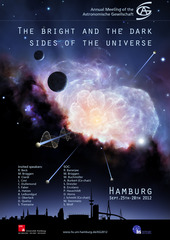 The DFG priority programme 1573 "The Physics of the Interstellar Medium" was newly established at the end of 2011 and was ment
to focus the effort of the German research community in the field of the interstellar medium. The aim of this splinter session
is to start a series of meetings to bring together scientists who address similar problems of ISM research with various techniques:
observations, laboratory experiments and simulations. We will reserve ample time for discussion on how to combine these various
findings in order to create a consistent picture of the most important physical processes of the turbulent ISM.
The DFG priority programme 1573 "The Physics of the Interstellar Medium" was newly established at the end of 2011 and was ment
to focus the effort of the German research community in the field of the interstellar medium. The aim of this splinter session
is to start a series of meetings to bring together scientists who address similar problems of ISM research with various techniques:
observations, laboratory experiments and simulations. We will reserve ample time for discussion on how to combine these various
findings in order to create a consistent picture of the most important physical processes of the turbulent ISM.
Galactic Scale Star Formation
Observation meets Theory, Heidelberg, July 30th - August 3rd, 2012
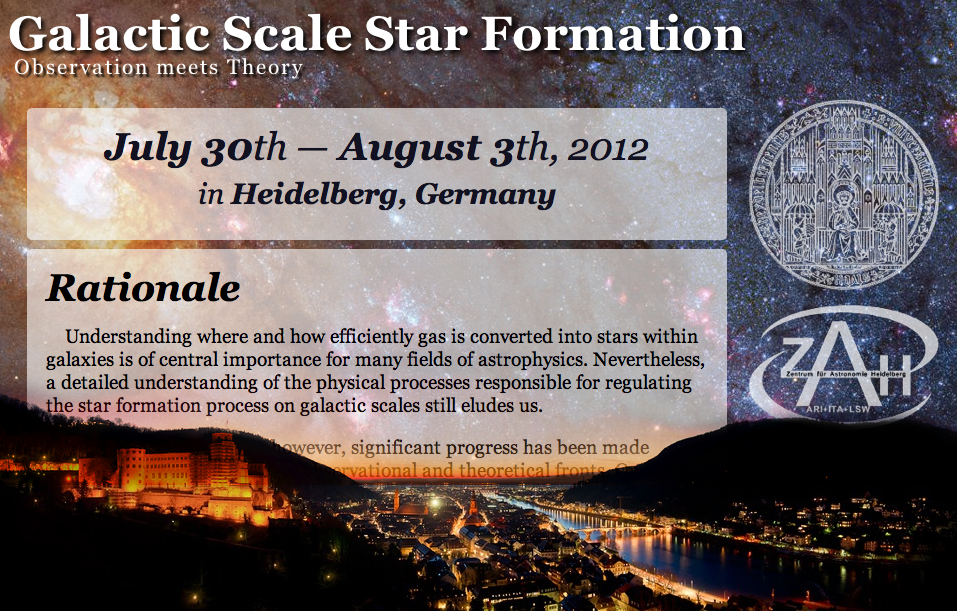 Understanding where and how efficiently gas is converted into stars within galaxies is of central importance for many fields of
astrophysics. Nevertheless, a detailed understanding of the physical processes responsible for regulating the star formation
process on galactic scales still eludes us.
Over the past few years, however, significant progress has been made towards this goal, on both the observational and theoretical
fronts. On the observational side, the recent years have seen an explosion of new, sensitive, high resolution observations of the
gas and young stars from the nearby universe out to distant galaxies. On the theoretical side, numerical simulations are finally
becoming capable of modelling the galactic interstellar medium in sufficient detail to allow star formation and stellar feedback
to be properly studied within galactic-scale simulations.
We therefore feel that the time is ripe for a conference bringing together observers and theorists working on the problem of star
formation and feedback on galactic scales.
Understanding where and how efficiently gas is converted into stars within galaxies is of central importance for many fields of
astrophysics. Nevertheless, a detailed understanding of the physical processes responsible for regulating the star formation
process on galactic scales still eludes us.
Over the past few years, however, significant progress has been made towards this goal, on both the observational and theoretical
fronts. On the observational side, the recent years have seen an explosion of new, sensitive, high resolution observations of the
gas and young stars from the nearby universe out to distant galaxies. On the theoretical side, numerical simulations are finally
becoming capable of modelling the galactic interstellar medium in sufficient detail to allow star formation and stellar feedback
to be properly studied within galactic-scale simulations.
We therefore feel that the time is ripe for a conference bringing together observers and theorists working on the problem of star
formation and feedback on galactic scales.
NAM 2012
UK-Germany National Astronomy Meeting in Manchester, UK, March 27-30, 2012
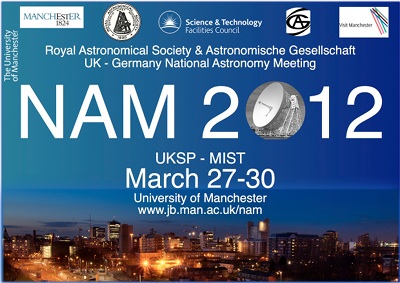 This combined meeting of the Royal Astronomical Society and the Astronomische Gesellschaft includes a session on
the Interstellar Medium and Star Formation, which is partly funded by the ISM priority programme. It is organised by Matthew Bate
and Andreas Burkert.
This combined meeting of the Royal Astronomical Society and the Astronomische Gesellschaft includes a session on
the Interstellar Medium and Star Formation, which is partly funded by the ISM priority programme. It is organised by Matthew Bate
and Andreas Burkert.
Kickoff-Meeting and Proposal Evaluation
Bildungszentrum Kardinal Döpfner Haus, Freising near Munich, May 2-3, 2011
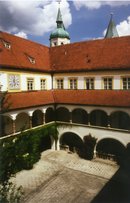 During the kickoff-meeting, proposers for the first funding period of the DFG priority program 1573 are
asked to present a poster of their project, which will then be evaluated by the reviewers.
The meeting is scheduled for May, 2-3, 2011 and will take place in the
"Bildungszentrum Kardinal Döpfner Haus" in Freising near Munich. It can
easily be reached by aeroplane, public transportation and car.
Details will be given in due time.
During the kickoff-meeting, proposers for the first funding period of the DFG priority program 1573 are
asked to present a poster of their project, which will then be evaluated by the reviewers.
The meeting is scheduled for May, 2-3, 2011 and will take place in the
"Bildungszentrum Kardinal Döpfner Haus" in Freising near Munich. It can
easily be reached by aeroplane, public transportation and car.
Details will be given in due time.
Important link:
Dynamical Processes in the ISM
Splinter session at the Annual Meeting of the Astronomische Gesellschaft,
University of Bonn, September 15-16, 2010
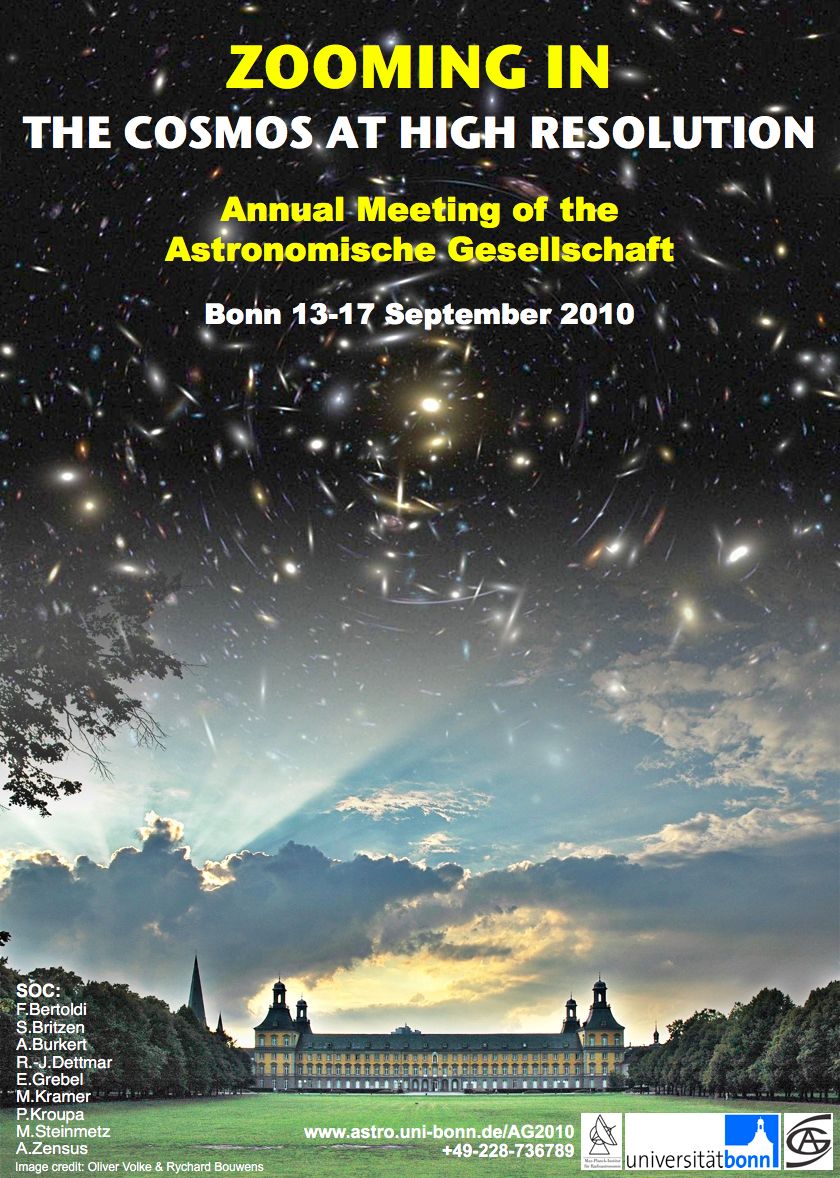 In this splinter meeting we want to introduce SPP 1573 to the German astronomical community, and bring together
scientists interested in this exciting field of research in order to synchronize and discuss potential SPP projects.
The ISM splinter meeting is scheduled for September 15th, from 14:30h to 18:30h and September 16th, from 14:30h to 18:30h.
In this splinter meeting we want to introduce SPP 1573 to the German astronomical community, and bring together
scientists interested in this exciting field of research in order to synchronize and discuss potential SPP projects.
The ISM splinter meeting is scheduled for September 15th, from 14:30h to 18:30h and September 16th, from 14:30h to 18:30h.
The program has now been assembled, please find the current schedule of the meeting here.
Important links:
 This priority program is funded by the German Research Foundation DFG.
This priority program is funded by the German Research Foundation DFG.
